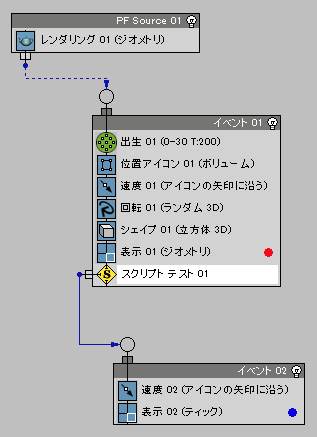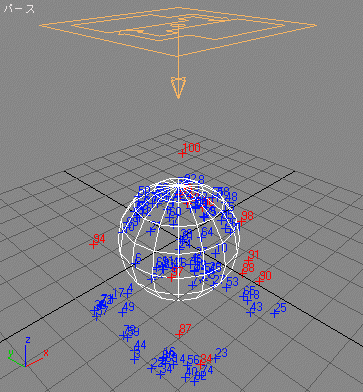Script Test 内の Age Test の例
説明:
次の例では、Script Test の Proceed ハンドラから Age Test の Proceed メソッドへのアクセスを示します。
用途:
Script_Test: ヘルパー内部で使用し、Age_Test: ヘルパーにアクセスする必要があります。

効果:
Init ハンドラにおいて Script_Test テストは、一意の Age Test アクションを作成するか、それが作成済みの場合は既存の Age Test アクションにアクセスします。次に、Age Test の Proceed メソッドを呼び出し、テスト結果を取得します。さらに、Age Test をまだ通過していないパーティクルのみを取り出し、球状ボリュームと照合します。ボリューム内部に落下しているパーティクルも、Script Test を通過します。
テストで True の返されたパーティクルは 2 番目のイベントに渡され、そこで停止します。最終結果は、すべてのパーティクルが古すぎるために停止するか、球状ボリュームに入ってしまっているために停止するかのどちらかです。
サンプル シーンでは、スクリプトによってテストされる球状ボリュームは、半径 20 の天球体で表されています。パーティクルは、球のサーフェスに残っているか、サーフェスの通過後、エージが球の範囲を超えたために停止しているかのどちらかです。

例:
--The ChannelsUsed handler defines the channels --to be made available to the script. --For the list of all channels, see --Interface: MaxscriptParticleContainer --The parameter pCont passed to the handler --contains the Particle Container the script is applied to on ChannelsUsed pCont do ( pCont.useTime = true --enable the Time channel pCont.usePosition = true --enable the Position channel pCont.useAge = true --enable the Age channel ) --The Init handler is called on initialization. --In this case, it is used to create the Age Test if it does not --exist yet, or get the existing one. on Init pCont do ( global ageT --If the unique object does not exist yet if $ageTest77777 == undefined then ( --Disable automatic event encapsulation particleFlow.BeginEdit() --Create a new Age Test ageT = Age_Test() --Give it a unique name! If you are reusing the code --multiple times, change the number to have a unique ID ageT.name ="ageTest77777" --Disable editing mode, enable auto-encapsulation particleFlow.EndEdit() --Set the Age Test value to 1600 ticks, no variation ageT.Test_Value = 1600 ageT.Variation = 0 ) else ageT = $ageTest77777--if the object exists, get it )--end init handler --In the Proceed handler, the Script Test calls the Proceed methods --of the Age Test to acquire its results and then checks the --the particles that have not passed the Age Test against --a spherical volume on Proceed pCont do ( --Get the current number of particles count = pCont.NumParticles() --Get the exact start and end time t_start = pCont.GetTimeStart() as time t_end = pCont.GetTimeEnd() as time t_start_frac = (pCont.GetTimeStart() as float) - (t_start as integer) t_end_frac = (pCont.GetTimeEnd() as float) - (t_end as integer) --Initialize a BitArray to store results testResult = #{} --Initialize an Array to store test times testTime = #() --Call the ProceedStep1 method of the Age Test ageT.proceedStep1 (pCont.GetParticleContainer()) (pCont.GetParticleSystem()) (pCont.getParticleSystemNode()) (pCont.getActionNode()) (pCont.getIntegrator()) --Call the ProceedStep2 method of the Age Test --The results will be returned in the by-reference variables ageT.proceedStep2 t_start t_start_frac &t_end &t_end_frac &testResult &testTime --If the particle system is not undefined if pCont.GetParticleSystem() != undefined then ( --Go through all particles for i in 1 to count do ( --If the i-th particle passed the Age Test if (testResult[i]) then ( --Set the current particle index pCont.particleIndex = i --Set the particle’s test status to true pCont.particleTestStatus = true --Set the particle’s Test time to the one returned by the --Age Test pCont.setParticleTestTimePrecise i t_start testTime[i] ) else ( --Set the current particle index pCont.particleIndex = i --Any particles inside a sphere with radius 20 --satisfy the test if length(pCont.particlePosition) < 20 then ( --Tell the particle it passed the test pCont.particleTestStatus = true --And set the test time to the current particle time pCont.particleTestTime = pCont.particleTime ) ) ) ) ) on Release pCont do ( )